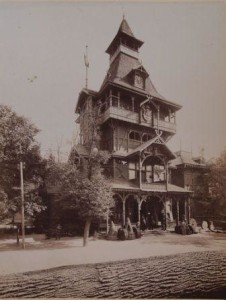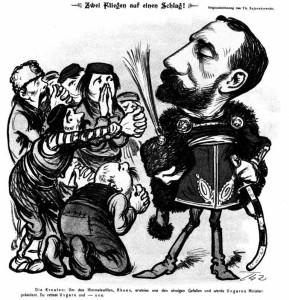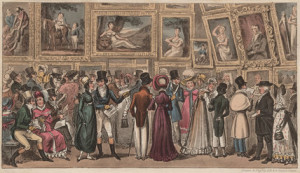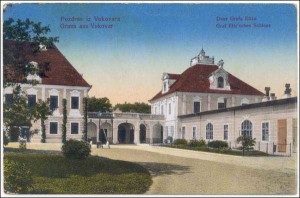With regard to the topics and scientific interests of the project members the research can be divided into four basic fields.
Research field 01 – Art in the Service of Politics
 Researchers will focus on those segments of the Croatian and Central European art that resulted from political projects, that is, activities of various governments and their ministries. Research will mainly focus on the works of architecture which represented a certain political regimes, and on other media such as graphic art and design, photography and public art. Researchers most actively involved in the field will be D. Damjanović who will explore great architectural projects in the Austro-Hungarian Empire and the Kingdom of Serbs, Croats and Slovenes; I. Iveljić who will do research into the impact of the power centres on Croatian 19th-century art, into organized support of Croatian governments for the education of artists and into selected topics in historical paintings; Z. Maković whose focus will be on the phenomenon of equestrian sculpture and public art in general, L. Magaš Bilandžić who will investigate graphic design, photography and the behind-the-scene reasons for the participation in important exhibitions in the interwar period and during the Second World War, D. Zec who will focus on modern sculptors, especially those active in the interwar period, S. Zadro whose research will include impacts of public institutions during the Austro-Hungarian and first Yugoslavian administration on the area of the present-day Bosnia and Herzegovina.
Researchers will focus on those segments of the Croatian and Central European art that resulted from political projects, that is, activities of various governments and their ministries. Research will mainly focus on the works of architecture which represented a certain political regimes, and on other media such as graphic art and design, photography and public art. Researchers most actively involved in the field will be D. Damjanović who will explore great architectural projects in the Austro-Hungarian Empire and the Kingdom of Serbs, Croats and Slovenes; I. Iveljić who will do research into the impact of the power centres on Croatian 19th-century art, into organized support of Croatian governments for the education of artists and into selected topics in historical paintings; Z. Maković whose focus will be on the phenomenon of equestrian sculpture and public art in general, L. Magaš Bilandžić who will investigate graphic design, photography and the behind-the-scene reasons for the participation in important exhibitions in the interwar period and during the Second World War, D. Zec who will focus on modern sculptors, especially those active in the interwar period, S. Zadro whose research will include impacts of public institutions during the Austro-Hungarian and first Yugoslavian administration on the area of the present-day Bosnia and Herzegovina.
Research field 02 – Art and Criticism of Political Circumstances
 This field includes research on those segments of artistic production which adopted a critical view of political regimes and gender, social, ethnic, racial and religious politics of governments. The artistic media which were most pronouncedly critical include caricature, comics, photography and political posters. The most active researchers in this field will be F. Dulibić who will analyze works of caricaturists from the interwar period and political comics during the Second World War and S. Bulimbašić who will explore art associations and artistic networks whose activities and worldviews opposed the dominant political currents.
This field includes research on those segments of artistic production which adopted a critical view of political regimes and gender, social, ethnic, racial and religious politics of governments. The artistic media which were most pronouncedly critical include caricature, comics, photography and political posters. The most active researchers in this field will be F. Dulibić who will analyze works of caricaturists from the interwar period and political comics during the Second World War and S. Bulimbašić who will explore art associations and artistic networks whose activities and worldviews opposed the dominant political currents.
Research field 03 – Museums and Exhibitions – a Means of Knowledge Creation and Dissemination
 Researchers active in this field will primarily investigate designs of permanent and temporary exhibitions – L. Magaš Bilandžić in their historical development and importance, and Ž. Miklošević from the perspective of contemporary museology – and the ways different media (art objects and interpretative tools alongside art objects) contribute to meaning making and representational practices relating to cultural, economic, national and other politics. This field will also include social science research into the reception of exhibition messages and the ways and types of meanings (and knowledge) that are created by museum visitors in terms of finding if interpretation of art by visitors is mainly an aesthetic experience or certain socio-political topics (if yes, which ones and how) are detected and how they are understood. Contributing to the theoretical background of this research field is N. Čačinovič’s exploration of the two-pronged cultural paradigm comprising aestheticism and the language of formal purity on the one hand, and endeavors of connecting artistic experience and everyday life on the other.
Researchers active in this field will primarily investigate designs of permanent and temporary exhibitions – L. Magaš Bilandžić in their historical development and importance, and Ž. Miklošević from the perspective of contemporary museology – and the ways different media (art objects and interpretative tools alongside art objects) contribute to meaning making and representational practices relating to cultural, economic, national and other politics. This field will also include social science research into the reception of exhibition messages and the ways and types of meanings (and knowledge) that are created by museum visitors in terms of finding if interpretation of art by visitors is mainly an aesthetic experience or certain socio-political topics (if yes, which ones and how) are detected and how they are understood. Contributing to the theoretical background of this research field is N. Čačinovič’s exploration of the two-pronged cultural paradigm comprising aestheticism and the language of formal purity on the one hand, and endeavors of connecting artistic experience and everyday life on the other.
Research field 04 – Cultural politics and unwanted artistic heritage
 This field includes research into the problems of preserving and neglecting parts of the national heritage from the 19th and early 20th centuries due to changes of political regimes. The most active researcher in the filed will be J. Najcer Sabljak and S. Lučevnjak who will investigate the destiny of the works formerly owned by Slavonian noblemen (the aristocratic families Odescalchi, Hilleprand-Prandau-Normann, Eltz); Z. Maković and L. Magaš Bilandžić who will do research into the circumstances of artistic production in relation to the Karađorđević dynasty, and D. Damjanović who will explore the destiny of artworks related to the Habsburg dynasty, and artistic heritage of national/religious minorities in Croatia. Ž. Miklošević will base her research on the historical research of other project members in order to investigate ways heritage and past are managed and interpreted by heritage/memory institutions (primarily museums) in the contexts of the difficult and dissonant heritage theories.
This field includes research into the problems of preserving and neglecting parts of the national heritage from the 19th and early 20th centuries due to changes of political regimes. The most active researcher in the filed will be J. Najcer Sabljak and S. Lučevnjak who will investigate the destiny of the works formerly owned by Slavonian noblemen (the aristocratic families Odescalchi, Hilleprand-Prandau-Normann, Eltz); Z. Maković and L. Magaš Bilandžić who will do research into the circumstances of artistic production in relation to the Karađorđević dynasty, and D. Damjanović who will explore the destiny of artworks related to the Habsburg dynasty, and artistic heritage of national/religious minorities in Croatia. Ž. Miklošević will base her research on the historical research of other project members in order to investigate ways heritage and past are managed and interpreted by heritage/memory institutions (primarily museums) in the contexts of the difficult and dissonant heritage theories.

